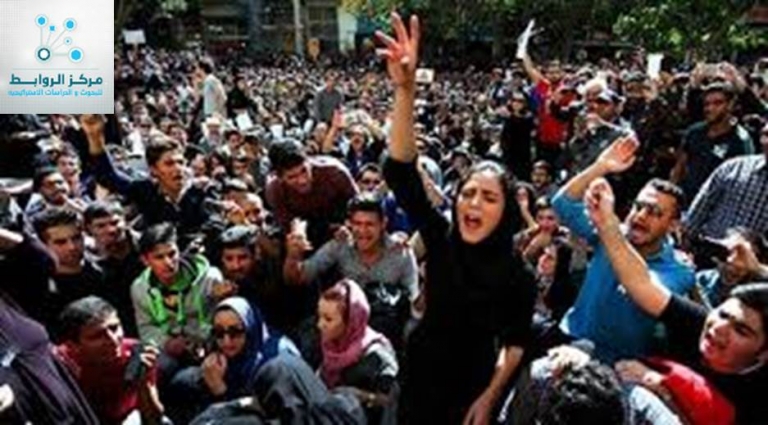The Iranian cities are witnessing wide demonstrations representing the voice of the oppressed Iranian people as a result of the injustice and arbitrariness and the wrong policies of the political system in Tehran in its dealings with nationalities and minorities, mismanagement and administration, the spread of political and economic corruption and the waste of the wealth of the Iranian people to the ambitions and whims of the regime and its expansionist project in expansion and influence within the Arab countries and the Middle East region and dreamed of playing a regional role that threatens the security and safety of the countries and the surrounding Arab countries by interfering in the internal affairs of these countries and threatening internal and national security .
The Iranian people have become resistant to these internal and external policies because they have begun to suffer, which reflected negatively on their lives and living in the form of rising prices, increasing unemployment, the spread of social corruption and the loss of the country’s wealth to the whims and goals sought by the rulers of Iran.
For these reasons, the reactions were great and witnessed the leading role of the youth of Iran in the movement to lead these demonstrations, protests, support and popular support represented by civil society organizations and leaders of liberal political parties and cultural associations of a cultural and human nature, which supported the demonstrations according to systematic plans to move from protest to raise prices of food and supply and fuel prices to protests calling for and demanding a change in the political system and departure and leave the rule to the will of the people to say its united word against the injustice and abuse experienced by Iran throughout the last four decades.
The basic motives and field objectives of popular demonstrations in Iran are determined in the following facts and evidence:
1. The bad economic situation and its deterioration and the lack of development plans in leading the process of economic progress in Iran and the lack of an effective economic policy to lift the Iranian economy out of its recession, especially after the sanctions imposed on Iran because of its nuclear program, which began to threaten its neighbors and Arab countries and became a threat to the international and Arab security and peace .
2. The Iranian economy remains unilaterally dependent on oil and gas exports and its financial revenues. This makes the Iranian economic vision lacks an important strategic depth for the economic structure and scientifically distanced itself from the establishment of high quality economic projects and legislation.
3. Criticism of Iran’s foreign policy ,in which the financial budget has borne many burdens due to the payments and financial expenses allocated to the expansionist Iranian project and the financial benefits paid by Iran in Syria to maintain the political system in Damascus and to support and enhance the armed militias fighting in Syrian territory in defense of the objectives and aspirations of the Iranian project in support of an important strategic ally is the Syrian regime, as well as the continued financial and armistice support of Hezbollah battalions and factions in southern Lebanon and other cities and countries that are a major concern of Tehran’s foreign policy.
4. The Iranian people feel that they are the first to support, provide services, develop economic life and living in Iran, take care of them and provide them with employment opportunities and establish effective economic projects that contribute to enhancing the future of youth and ending the problem of unemployment away from the political goals of the Iranian regime in Damascus, Beirut Gaza , Sana’a and other countries because the Iranian people see themselves as more deserving of this money than other peoples and nations.
5.The spread of demonstrations to extend to all Iranian provinces and all the Iranian people of different nationalities and religious and ethnic affiliations took part in it noting that the protests witnessed large waves in the center of Tehran and the city of Mashhad, which is the second most densely populated city in Iran and the Kurdish- majority city of Kermanshah , Arab cities of Ahwaz and the cities of Arak , Shiraz and Muhammarah( Khorramshahr ) and the rest of the other provinces, this diversity indicates that the general Iranian people reject the policy of the ruling regime.
There were slogans at the beginning of the demonstrations denouncing the bad economic situation, but it surprised the religious leaderships in Iran The demonstrators shouted slogans against the supreme leader Ali Khamenei, but began to burn his pictures and chant slogans (Death to Rohani and Khamenei) and the down of the dictator Khamenei, the slogans of discontent and resentment and the refusal to the religious authority in Iran.
7. The leaders of the Iranian Revolutionary Guards have threatened to intimidate the demonstrators and warn them against continuing their demonstrations and that they will use all means to suppress the demonstrators and arrest their leaders as they have begun to pose a grave danger to the regime and its military and security institutions and threaten the safety and survival of the religious and political authorities considering the revolutionary guard as an important arm in which Ali Khamenei depends on in the leadership of the state and the management of political, security and military affairs and the implementation of the Iranian expansionist project.
8. The public bankruptcy of a number of major Iranian economic companies and institutions and the announcement of its r failure to manage their projects and the loss of all its funds and investments, which resulted in the loss of the funds of thousands of investors and the dismissal of 27 thousand people from work, which increased the economic suffering of the people of Iran and the deteriorating economic situation and the spread of unemployment.
Iranian Studies Unit
Rawabet Center for Research and Strategic Studies

